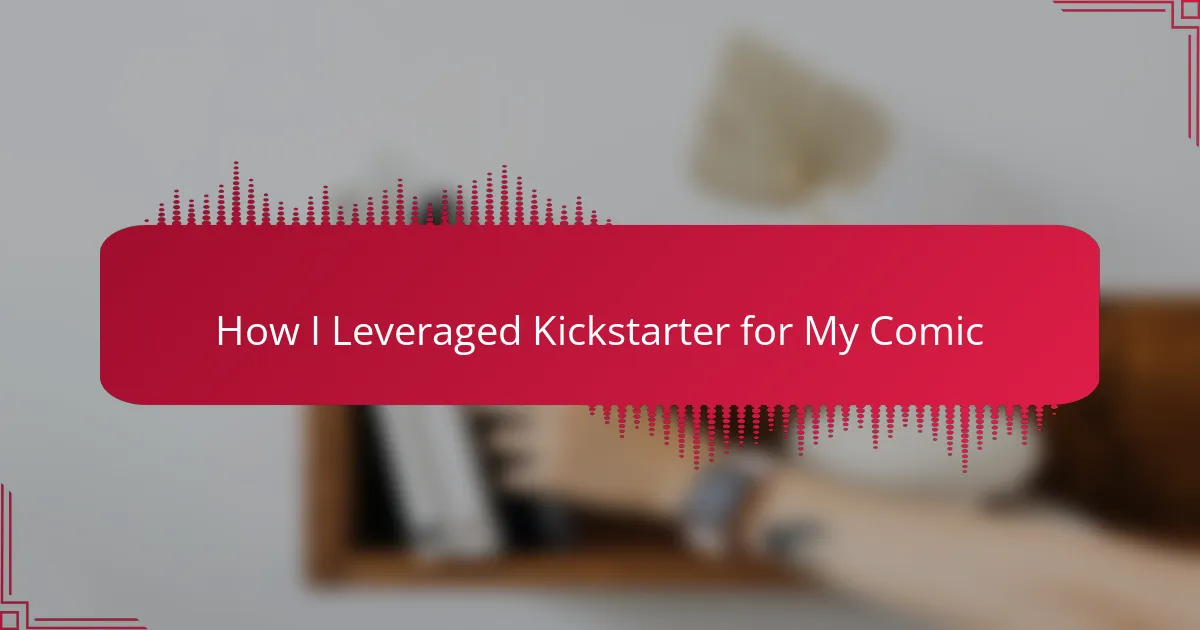Key takeaways
- Kickstarter is not just for funding; it fosters community engagement, allowing authors to connect with backers who share their passion.
- Successful campaigns prioritize clear goals, compelling storytelling, and transparent communication about project needs and progress.
- Personalized reward tiers and regular updates keep backers invested and create a sense of shared ownership in the project.
- Thorough planning and logistics management are essential to avoid delays and ensure a smooth fulfillment process, enhancing backer satisfaction.
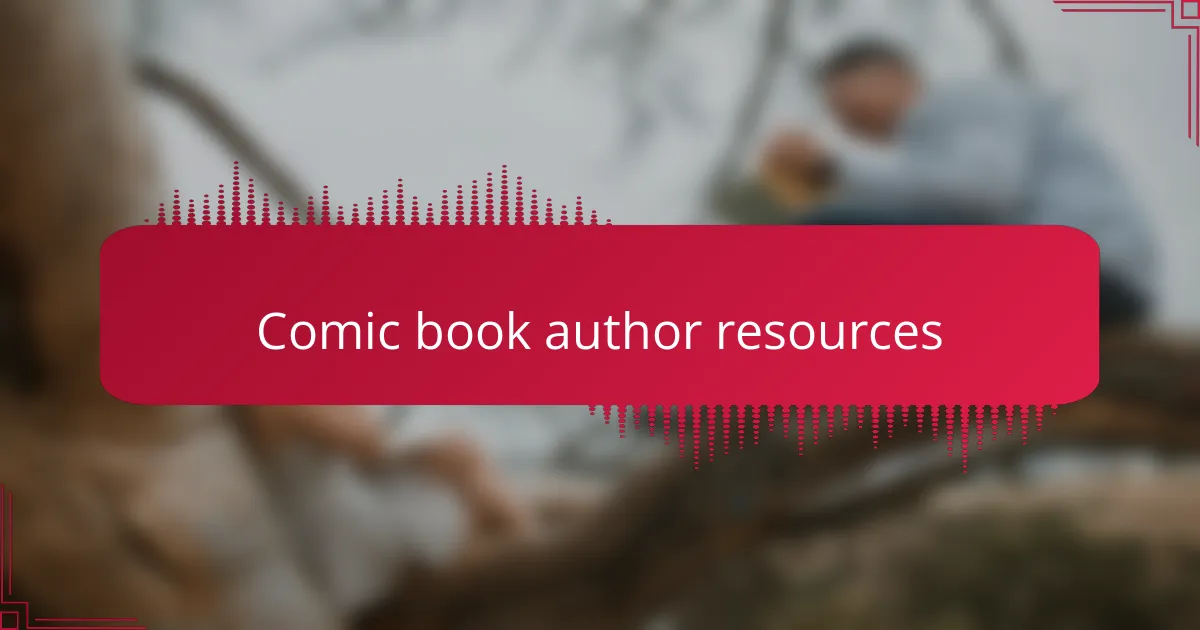
Comic book author resources
As a comic book author, tapping into resources available can really elevate your work from a passion project to something more impactful. One resource that stands out is Kickstarter. I remember my own experience launching my comic project there. It was nerve-wracking yet exhilarating to engage directly with my audience and watch the funding grow.
Navigating the landscape of comic book author resources can be overwhelming, but it’s often about finding the right fit for your needs. Whether it’s funding, marketing strategies, or community support, understanding what options are out there is essential. When I first started, I relied heavily on forums and online groups for advice, and it truly felt like I was part of a supportive family.
Here’s a comparison table of some popular comic book author resources:
| Resource | Description |
|---|---|
| Kickstarter | Ideal for funding and direct engagement with backers. |
| Webtoon | A platform for webcomics, with a built-in audience and monetization options. |
| Comic Book Creator Forums | Communities offering advice, critiques, and networking. |
| Social Media Groups | Great for promotion, sharing experiences, and finding collaborators. |
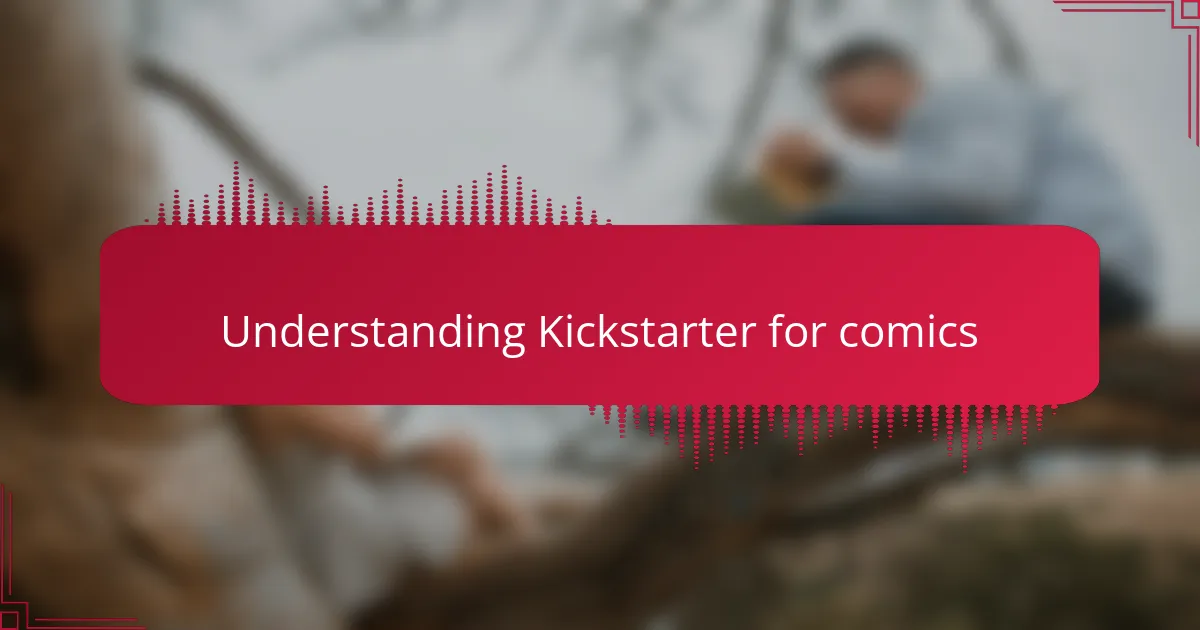
Understanding Kickstarter for comics
Understanding Kickstarter for comics involves grasping not just the platform itself, but also the unique community it fosters. I recall the thrill of crafting my campaign, knowing that I was directly connecting with potential fans. It made me realize that Kickstarter is more than just a funding platform; it’s a space where you can share your story and vision with backers who genuinely care.
When I dove into my project, I discovered that setting clear goals and offering enticing rewards were key to capturing interest. I often wondered how to make my offers compelling, and through feedback, I learned that unique incentives, like original sketches or behind-the-scenes content, truly resonated with backers. Each interaction helped me refine my ideas and build a foundation of support that was invaluable.
The importance of transparency cannot be overstated. As I shared my journey, including challenges and successes, I noticed that backers became more invested in my project. It’s like we were all part of a collaborative adventure, fueling each other’s passion and creativity. Have you ever felt that connection with an audience? That shared enthusiasm is what makes Kickstarter an exciting option for comic creators like us.
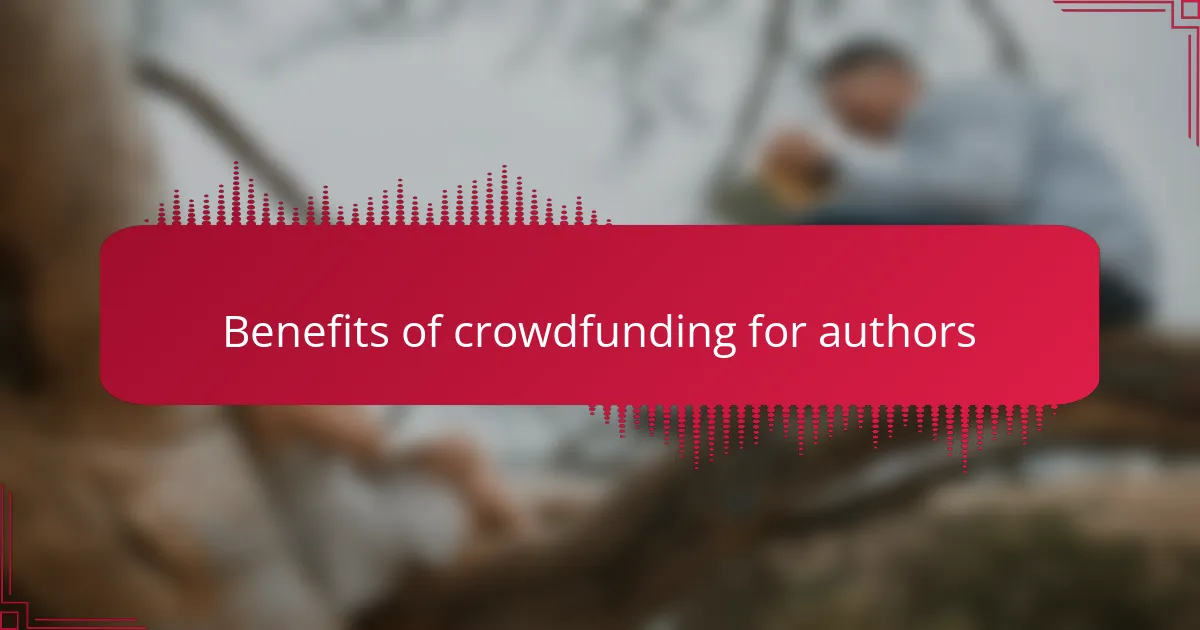
Benefits of crowdfunding for authors
When I first considered crowdfunding for my comic, I was excited about the potential benefits. It’s not just about raising funds; it’s about building a community. I found that engaging with backers created a sense of shared ownership and excitement around the project.
Crowdfunding also allowed me to test the waters for my comic’s appeal. The feedback I received was invaluable, helping me to refine my story and art style based on what potential readers were excited about. That kind of direct connection felt empowering and motivated me to push the boundaries of my creativity.
On a practical level, I saw that crowdfunding platforms often provided resources and exposure that I wouldn’t have found elsewhere. The promotional tools and community support were truly instrumental in my success. It’s a collaborative journey that many authors might overlook.
| Benefit | Description |
|---|---|
| Community Engagement | Connect with backers and create a sense of shared ownership. |
| Market Validation | Test your comic’s appeal before full production. |
| Resource Access | Utilize platform tools and support networks for promotion and guidance. |
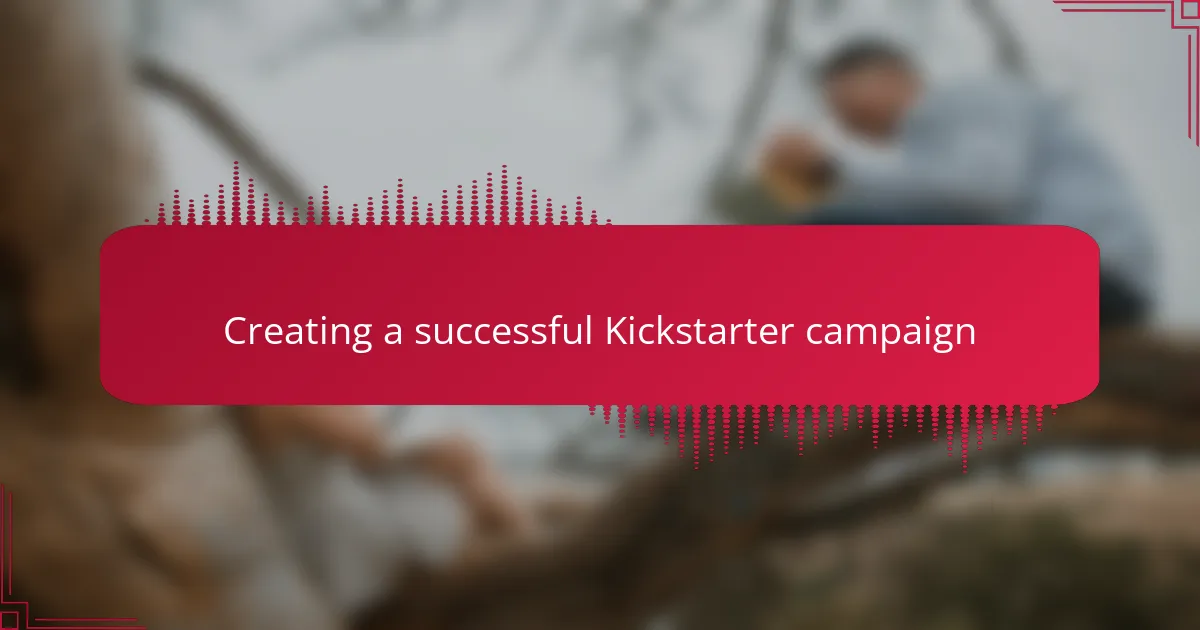
Creating a successful Kickstarter campaign
Creating a successful Kickstarter campaign hinges on understanding your audience and crafting a compelling narrative. I remember staring at the blank page of my campaign for hours, debating how to convey the heart of my comic. The moment I shifted my focus from just selling a product to telling my story, everything started to click. There’s something magical about sharing your passion; it draws people in and ignites their interest.
Setting a realistic funding goal was another crucial piece of my strategy. I initially calculated my needs rather liberally, but after some research and feedback from fellow creators, I adjusted it to a more achievable figure. By clearly outlining what the funds would cover—like printing costs and artwork—I found backers appreciated the transparency. Have you ever felt that moment when a clear figure suddenly makes your vision tangible? It’s a vital step toward instilling confidence in your backers.
Additionally, I learned that creating attractive reward tiers can be a game-changer. I experimented with different offerings, from digital copies to exclusive merchandise. I found that people loved personalized touches, like handwritten thank-you notes or commissioned sketches. Each tier was an opportunity to deepen engagement with supporters, making them feel included in my journey. So, what unique rewards can you offer that might resonate with your audience? This personal touch can elevate your campaign and foster lasting connections.
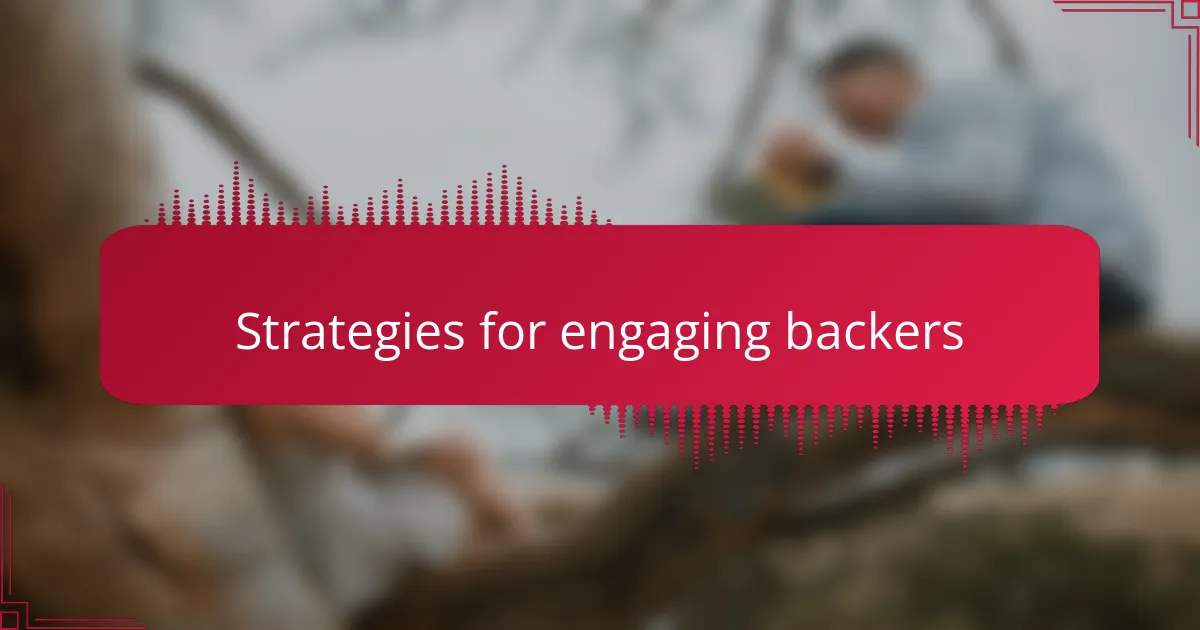
Strategies for engaging backers
Engaging backers is an art that goes beyond simply asking for funds. During my campaign, I discovered that regular updates kept my backers invested and excited about the journey. Each update felt like a personal conversation—sharing progress, revealing artwork, or even discussing challenges. I often wondered, how can I make backers feel that their support is making a real difference? By showing them the impact of their contributions through these updates, I created a bond that felt like we were working toward a common goal.
Another strategy that worked wonders for me was active engagement on social media. I remember hosting live Q&A sessions where backers could ask anything about the comic. It was thrilling to connect directly with my audience. This two-way communication not only made them feel valued but also created a sense of community around my project. Have you ever experienced that rush of excitement when someone engages with your work? It’s a powerful motivator that can drive even more support.
Lastly, I found that offering exclusive behind-the-scenes access turned the engagement dial up a notch. Sharing sketches, early drafts, or insights into my creative process made backers feel like they were part of something special. For instance, I included a tier where backers could join a private newsletter. This fostered a sense of insider knowledge and gave them something to look forward to. What unique experiences can you offer your backers that will make them feel directly connected to your project? Engaging them in this way not only increases support but also builds lasting relationships.
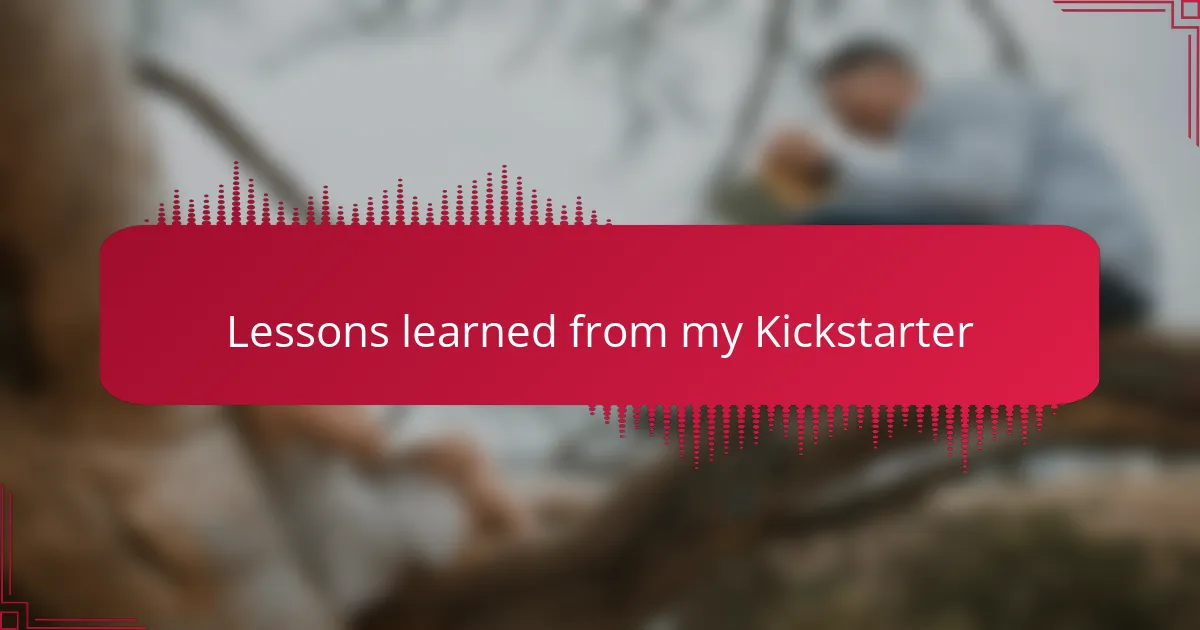
Lessons learned from my Kickstarter
One of the most vital lessons I learned from my Kickstarter experience is the importance of community engagement. Early on, I realized that simply reaching out to potential backers wasn’t enough; I had to make genuine connections with them. I remember feeling overwhelmed yet energized when I hosted live Q&A sessions—seeing real-time feedback and excitement from supporters helped to fuel my project.
Another key insight was the necessity of thorough planning. I had underestimated the logistics involved in fulfillment, which led to some delays and stressed interactions with backers. A moment that stands out for me was when I had to pivot and come up with quick solutions, but it taught me the importance of building a buffer into my timelines.
Lastly, I found that storytelling is paramount. Sharing my journey, the highs and lows, and how backers could relate to my comic made them feel invested. It was moving to receive messages from backers who felt connected to my creative process, as it reinforced the mission of creating art that resonates on a personal level.
| Lesson Learned | Personal Insight |
|---|---|
| Community Engagement | Building genuine connections helped elevate my project and foster excitement. |
| Thorough Planning | Anticipating logistics prevented stress and made fulfillment smoother. |
| Storytelling | Sharing my journey made backers feel personally invested in my comic. |
